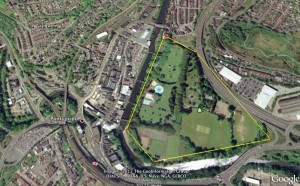Ease ****
Overview
Google Earth has been around for some time but it continues to offer opportunities for great cross-curricular teaching and learning. Here, we used the the Line and Path measurement tools to find distances that are challenging to measure. For ease of writing, Google Earth is sometimes referred to as GE here.
Description
Before starting, go to the Google Earth website. If the software isn’t already installed on your computer you’ll need to do this before starting – it’s not difficult and is completely free! Once it’s downloaded it should start up immediately, if it doesn’t click on the GE icon on your desktop. The GE window will open, close any pop-ups that may appear unless you’d like to take a tour of the site or learn about new tools added to the software. Ask learners to experiment with the circular controls in the right hand corner of the pane. These control rotation and direction and are easy to use after a little experimentation! They can also manipulate the earth with the cursor and mouse – encourage them to have a go! Ask them to position the part of the Earth you wish to investigate further at the centre of the window (if the Earth continues to revolve having done this, click in space and it should stop) To zoom in, slide or click on the magnifying slider underneath the circular controls. Continue to do this until you reach the level of magnification that you require. Find a regular shaped feature on a map – say a local football pitch – and ask children to measure it using the line and path function The icon is at the top of the pane and has a small blue ruler on it.
Perimeter is easy, GE will do this automatically. Measuring the perimeter may be enough at this stage so ask them to measure the perimeter of other features in the locale.
Area is done in much the same way, but it is important that learners make a note of the length of the first side and then delete it and draw another line in order to get the an accurate measurement for the second side as consecutive measurements are added to each other. If you want to challenge pupils ask them to subtract the first measurement from the total of the first two sides in order to get an accurate second measurement. Then calculate the area a = l x b.
What do I need?
- Internet connection
- GE download http://www.google.com/earth/index.html
Added value
There are some online tools which makes something that has always been problematic very easy. This is one of them. The days of trundling around the school with a metre wheel may be long gone! (We hope, anyway).
Hints and tips
Don’t get too hung-up about accuracy when learners are just beginning to use the software. We’ve found that accuracy improves with repeated use. Also, the features being measured are usually quite large, so inaccuracies will be very small in overall.
Safety
There are no safety issues relating to this software.
Other opportunities to use the same software
- Use GE to get approximate measurements of local geographical features.
- Add complexity by measuring an irregular shape – such as a park – and get them to work out the approximate perimeter and the approximate area by splitting the shape into other regular shapes they are able to calculate. Tell them it is useful to do a rough sketch of the shape first to decide have they are going to divide it up. This can depend on age and ability
- Use it to look at the ratio of green space to built up areas in a given area as part of an environmental project. Or calculate the amount of woodland or arable land.
- If they are old enough to be able to triangulate the shape then they should be able to calculate the shape just using the path function on GE to get the perimeter. Or do the above with upper age secondary children using calculus!
This post is also available in: Dutch, Italian, Portuguese (Portugal), Romanian, Welsh





 English
English Nederlands
Nederlands Deutsch
Deutsch Italiano
Italiano Español
Español Português
Português Română
Română Cymraeg
Cymraeg
Why not click on the ‘moon’ feature and measure the circumference? Measurements are approximate of course but gives older pupils to work with larger numbers…. HUGE numbers! They’ll love it.